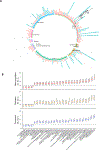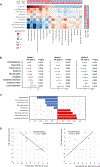Gut Microbiota and Blood Metabolites Related to Fiber Intake and Type 2 Diabetes
- PMID: 38547246
- PMCID: PMC10987058
- DOI: 10.1161/CIRCRESAHA.123.323634
Gut Microbiota and Blood Metabolites Related to Fiber Intake and Type 2 Diabetes
Abstract
Background: Consistent evidence suggests diabetes-protective effects of dietary fiber intake. However, the underlying mechanisms, particularly the role of gut microbiota and host circulating metabolites, are not fully understood. We aimed to investigate gut microbiota and circulating metabolites associated with dietary fiber intake and their relationships with type 2 diabetes (T2D).
Methods: This study included up to 11 394 participants from the HCHS/SOL (Hispanic Community Health Study/Study of Latinos). Diet was assessed with two 24-hour dietary recalls at baseline. We examined associations of dietary fiber intake with gut microbiome measured by shotgun metagenomics (350 species/85 genera and 1958 enzymes; n=2992 at visit 2), serum metabolome measured by untargeted metabolomics (624 metabolites; n=6198 at baseline), and associations between fiber-related gut bacteria and metabolites (n=804 at visit 2). We examined prospective associations of serum microbial-associated metabolites (n=3579 at baseline) with incident T2D over 6 years.
Results: We identified multiple bacterial genera, species, and related enzymes associated with fiber intake. Several bacteria (eg, Butyrivibrio, Faecalibacterium) and enzymes involved in fiber degradation (eg, xylanase EC3.2.1.156) were positively associated with fiber intake, inversely associated with prevalent T2D, and favorably associated with T2D-related metabolic traits. We identified 159 metabolites associated with fiber intake, 47 of which were associated with incident T2D. We identified 18 of these 47 metabolites associated with the identified fiber-related bacteria, including several microbial metabolites (eg, indolepropionate and 3-phenylpropionate) inversely associated with the risk of T2D. Both Butyrivibrio and Faecalibacterium were associated with these favorable metabolites. The associations of fiber-related bacteria, especially Faecalibacterium and Butyrivibrio, with T2D were attenuated after further adjustment for these microbial metabolites.
Conclusions: Among United States Hispanics/Latinos, dietary fiber intake was associated with favorable profiles of gut microbiota and circulating metabolites for T2D. These findings advance our understanding of the role of gut microbiota and microbial metabolites in the relationship between diet and T2D.
Keywords: diabetes mellitus, type 2; dietary fiber; gastrointestinal microbiome; genes, bacterial; metabolome.
Conflict of interest statement
Figures




References
-
- Jenkins DJA, Kendall CWC, McKeown-Eyssen G, Josse RG, Silverberg J, Booth GL, Vidgen E, Josse AR, Nguyen TH, Corrigan S,et al. Effect of a low-glycemic index or a high-cereal fiber diet on type 2 diabetes: A randomized trial. JAMA - Journal of the American Medical Association.2008;300:2742–2753. doi:10.1001/jama.2008.808. - DOI - PubMed
-
- Kaplan RC, Wang Z, Usyk M, Sotres-Alvarez D, Daviglus ML, Schneiderman N, Talavera GA, Gellman MD, Thyagarajan B,et al. Gut microbiome composition in the Hispanic Community Health Study/Study of Latinos is shaped by geographic relocation, environmental factors, and obesity. Genome Biol.2019;20: 219–z. doi:10.1186/s13059-019-1831-z. - DOI - PMC - PubMed
MeSH terms
Substances
Grants and funding
- R01 DK120870/DK/NIDDK NIH HHS/United States
- N01 HC065236/HL/NHLBI NIH HHS/United States
- K01 HL169019/HL/NHLBI NIH HHS/United States
- R01 DK134672/DK/NIDDK NIH HHS/United States
- R01 HL140976/HL/NHLBI NIH HHS/United States
- N01 HC065237/HL/NHLBI NIH HHS/United States
- R01 HL136266/HL/NHLBI NIH HHS/United States
- R01 DK126698/DK/NIDDK NIH HHS/United States
- N01 HC065233/HL/NHLBI NIH HHS/United States
- R01 MD011389/MD/NIMHD NIH HHS/United States
- N01 HC065235/HL/NHLBI NIH HHS/United States
- R01 DK119268/DK/NIDDK NIH HHS/United States
- R01 HL170904/HL/NHLBI NIH HHS/United States
- N01 HC065234/HL/NHLBI NIH HHS/United States
- K01 HL129892/HL/NHLBI NIH HHS/United States
- P30 DK111022/DK/NIDDK NIH HHS/United States
- R01 HL060712/HL/NHLBI NIH HHS/United States
- UM1 HG008898/HG/NHGRI NIH HHS/United States

